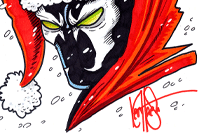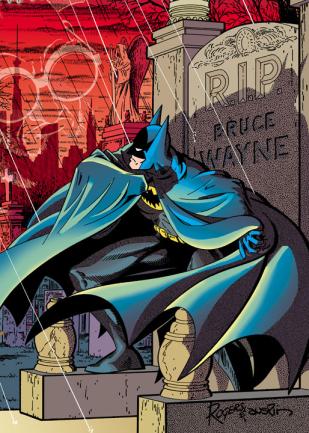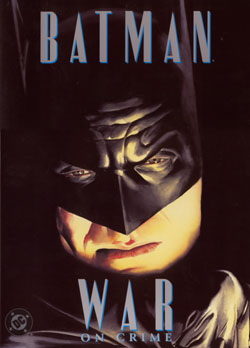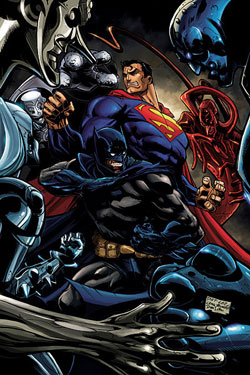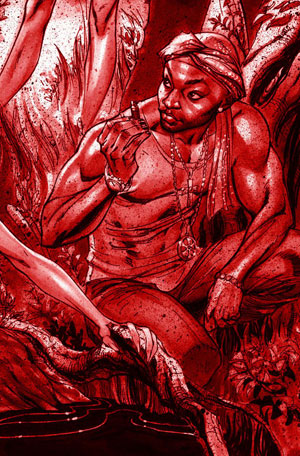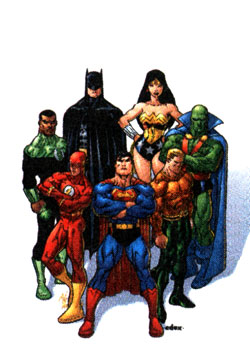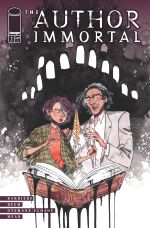|

|
BATMAN This article is about the character. For other uses, see Batman (disambiguation).
Batman
Second printing cover to Batman #608 (Oct. 2002).
Art by Jim Lee (pencils) and Scott Williams (inks).
Publisher DC Comics
First appearance Historical:
Detective Comics #27
(May 1939)
Modern:
Batman #404 -
"Batman: Year One", part 1
(Feb. 1987)
Created by Bob Kane
Bill Finger
Characteristics
Alter ego Bruce Wayne
Affiliations Batman Family
Justice League
Wayne Enterprises
Outsiders
Notable aliases Matches Malone
Abilities Genius-level intelligence,
Master detective,
Peak human physical condition,
Martial arts master,
Escapologist,
Access to high tech equipment.
Batman (originally referred to as the Bat-Man and still referred to at times as the Batman) is a DC Comics fictional superhero who first appeared in Detective Comics #27 in May 1939. Batman was co-created by artist Bob Kane and writer Bill Finger, although only Kane receives official credit. Batman has since become one of the world's most recognized superheroes.
Batman's secret identity is Bruce Wayne, a billionaire industrialist, playboy, and philanthropist. Witnessing the murder of his parents as a child leads him to train himself to the peak of physical and intellectual perfection, don a bat-themed costume, and fight crime. Unlike most superheroes, he does not possess superhuman Powers or abilities; he makes use of intellect, detective skills, science and technology, wealth, physical prowess and intimidation in his war on crime.
Creation
In early 1938, the success of Superman in Action Comics prompted editors at the comic book division of National Publications (the future DC Comics) to request more superheroes for its titles. In response, Bob Kane created "the Bat-Man". Collaborator Bill Finger recalled that Kane
" had an idea for a character called 'Batman', and he'd like me to see the drawings. I went over to Kane's, and he had drawn a character who looked very much like Superman with kind of ... reddish tights, I believe, with boots ... no gloves, no gauntlets ... with a small domino mask, swinging on a rope. He had two stiff wings that were sticking out, looking like bat wings. And under it was a big sign ... Batman. "
Finger offered such suggestions as giving the character a cowl instead of a simple domino mask, wearing a cape instead of wings, wearing gloves, and removing the red sections from the original costume. Finger said he devised the name Bruce Wayne for the character's secret identity: "Bruce Wayne's first name came from Robert Bruce, the Scottish patriot. Wayne, being a playboy, was a man of gentry. I searched for a name that would suggest colonialism. I tried Adams, Hancock ... then I thought of Mad Anthony Wayne". Inspirations for Batman's personality, character history, visual design and equipment include[citation needed] movies such as Douglas Fairbanks' The Mark of Zorro, The Bat, and Dracula; characters such as The Shadow, The Phantom, Sherlock Holmes, Dick Tracy, Jimmie Dale, The Green Hornet, Spring Heeled Jack; and Leonardo Da Vinci's drawings of a flying machine.
Kane signed away any ownership in the character in exchange for, among other compensation, a mandatory byline on all Batman comics. This byline did not, originally, say "Batman created by Bob Kane"; his name was simply written on the title page of each story. The name disappeared from the comic book in the mid-1960s, replaced by credits for each story's actual writer and artists. In the late 1970s, when Jerry Siegel and Joe Shuster began receiving a "created by" credit on the Superman titles, along with William Moulton Marston being given the byline for creating Wonder Woman, Batman stories began saying "Created by Bob Kane" in addition to the other credits.
Finger did not receive the same recognition. While he had received credit for other DC work since the 1940s, he began, in the 1960s, to receive limited acknowledgment for his Batman writing; in the letters page of Batman #169 (Feb. 1965) for example, editor Julius Schwartz names him as the creator of the Riddler, one of Batman's recurring villains. However, Finger's contract left him only with his writing page rate and no byline. Finger, like Shuster, Siegel, and some other creators during and after the Golden Age of Comic Books, would resent National's denying him the money and credit he felt was owed for his creations. At the time of Finger's death in 1974, DC had not officially credited Finger as Batman co-creator. Kane himself, however, in later years willingly acknowledged Finger's contributions to the character while also insisting on his own role.
Early years (1939-1949)
The first Batman story appeared in May 1939. Finger said, "Batman was originally written in the style of the pulps" and this influence was evident with Batman showing little remorse over killing or maiming criminals and was not above using firearms. The Bat-Man was a breakout hit, with sales on Detective Comics soaring to the point that the character was given his own title in 1940. By that time National was the top-selling and most influential publisher in the industry, and Batman and National's other major hero Superman were the cornerstones of the company's success. The two characters were featured side-by-side as the stars of World's Finest Comics, which was originally titled World's Best Comics when it debuted in fall 1940. Creators including Jerry Robinson and Dick Sprang also worked on the strips during this period.
Over the course of the first few Batman strips elements were added to the character and Kane's artistic depiction of Batman evolved. Kane noted within six issues he drew the character's jaw more pronounced and lengthened the ears on the costume; "About a year later he was almost the full figure, my mature Batman," Kane said. Batman's characteristic utility belt was introduced in Detective Comics #29 (July 1939), followed by the batarang and the first bat-themed vehicle in #31 (Sept. 1939), and the character's origin was revealed in #33 (Nov. 1939). The early pulp-influenced portrayal of Batman started to soften in Detective Comics #38 in 1940 with the introduction of Robin, Batman's kid sidekick. Robin - whose name was based on that of Robin Hood - was introduced based on Finger's suggestion to Kane that Batman needed a "Watson" with whom Batman could talk. The first issue of Batman was notable not only for introducing two of Batman's most persistent antagonists, the Joker and Catwoman, but for one of the stories in the issue where Batman shoots some monstrous giants to death, which prompted editor Whitney Ellsworth's decree that the character could no longer kill or use a gun. Batman's tone continued to stay light for the next several decades.
The fifties and early sixties (1950-1963)
In the story "The Mightiest Team In the World" by writer Edmund Hamilton and penciler Curt Swan in Superman #76 (June 1952), Batman first teams up with Superman and learns his secret identity; following the success of this story, the separate Batman and Superman features that had been running in World's Finest Comics instead featured both together; this series of stories ran until the book's cancellation in 1986. The stories feature the two as close friends and allies, tackling threats that require both of their talents.
Batman was one of the few superhero characters to be continuously published as interest in the genre waned during the 1950s. Starting in the mid-1950s, Batman's stories gradually become more science fiction-oriented, an attempt at mimicking the success of the top-selling Superman comics of the time. New characters such as Batwoman, Ace the Bat-Hound, and Bat-Mite (the latter two paralleling Krypto the Superdog and Mr. Mxyzptlk of the Superman titles) were introduced. Batman has adventures involving either odd transformations or dealing with bizarre space aliens. Batman is a highly public figure during the stories of the 1950s, regularly appearing at events such as charity functions and frequently appearing in broad daylight. In 1960, Batman becomes a member of the Justice League of America, which debuts in The Brave and the Bold #28 (Feb. 1960).
"New Look" Batman and camp (1964-1969)
By 1964 sales on Batman titles had fallen drastically; Bob Kane noted that as a result " were planning to kill Batman off altogether." Editor Julius Schwartz was soon assigned to the Batman titles and presided over drastic changes. Beginning with 1964's Detective Comics #327 (May 1964) - cover-billed as the "New Look" - Schwartz introduced changes designed to make Batman more contemporary and return him to more detective-oriented stories, including a redesign of Batman's equipment, the Batmobile, and his costume (introducing the yellow ellipse behind the costume's bat-insignia), and brought in artist Carmine Infantino to help in this makeover. The space aliens and characters of the 1950s such as Batwoman, Ace, and Bat-Mite were retired. Batman's erstwhile butler Alfred Pennyworth was even killed off and replaced with Aunt Harriet, who came to live with Bruce and Dick.
The debut of the Batman TV series in 1966 had a profound influence on the character. In addition to initiating the return of Alfred and the introduction of Batgirl, the show's campy nature found its way into the comics. Although both the comics and TV show were successful for a time, the camp approach eventually wore thin and the show was cancelled in 1968. In the aftermath the Batman comics themselves lost popularity once again. As Julius Schwartz noted, "When the television show was a success, I was asked to be campy, and of course when the show faded, so did the comic books."
O'Neil and Adams (1970-1985)
Writer Dennis O'Neil and artist Neal Adams made a deliberate effort to distance Batman from the campy portrayal of the 1960s TV series and to return the character to his roots as a "grim avenger of the night." The O'Neil/Adams era began in earnest starting with Detective Comics #395's "The Secret of the Waiting Graves" (1970). Dick Grayson had been sent off to college in a story written by Frank Robbins, making Batman a loner once again. O'Neil's tone influenced Batman comics through the rest of the 1970s and into the 1980s; 1977 and 1978's stories in Detective Comics written by Steve Englehart (with art by Marshall Rogers) are held by many as a high point of this era.
The Dark Knight Returns and modern Batman (1986-present)
Frank Miller's 1986 limited series Batman: The Dark Knight Returns, which tells the story of a 50-year-old Batman coming out of retirement in a possible future, returned the character to his dark roots. The Dark Knight Returns was a financial success and has since become one of the seminal works in comic book history.
The series also sparked a major resurgence in the character's popularity. That year Dennis O'Neil took over as editor of the Batman titles and set the template for the portrayal of Batman following DC's status quo-altering miniseries Crisis on Infinite Earths. O'Neil operated under the assumption that he was hired to revamp the character and as a result tried to instill a different tone in the books than had gone before. One outcome of this new approach was the "Year One" storyline in Batman #404-407, where Frank Miller and artist David Mazzucchelli redefined the character's origins. Alan Moore and Brian Bolland continued this dark trend with 1988's Batman: The Killing Joke, in which the Joker, attempting to drive Commissioner Gordon insane, cripples his daughter Barbara Gordon, kidnaps him, and tortures him physically and mentally. These stories and others like them helped to raise the Image of comic books beyond mere children's entertainment. Batman: The Dark Knight Returns and stories following it (such as John Byrne's Superman revamp) also severed the close friendship of Batman and Superman, replacing it with a more antagonistic relationship.
Since the publication of "Year One," many creators have set their stories in Batman's formative years, and the Batman title Legends of the Dark Knight in particular often features stories that take place in Batman's early days. Many of the stylistic notes of Year One, specifically text captions designed to look handwritten on note paper, have also been used quite successfully by other authors. In addition, the general concept of a Year One book, taking a fresh look at the origins of an older character, as well as showing their learning process, has been embraced by the comics industry as a whole. Other comics which have since gotten a "Year One" treatment include Spider-Man and the Justice League.
The Batman comics garnered major attention in 1988 when DC Comics created a 900 number for readers to call to vote on whether Jason Todd, the second Robin, lived or died. Voters decided in favor of Jason's death by a narrow margin of 28 votes. 1993's "Knightfall" series introduces a new villain named Bane, who critically injures Batman. Jean-Paul Valley, known as Azrael, is called upon to wear the Batsuit during Bruce's convalescence. Writers Doug Moench, Chuck Dixon, and Alan Grant worked on the Batman titles during "Knightfall" and would also contribute to other Batman crossovers throughout the 1990s. 1998's "Cataclysm" storyline served as the precursor to 1999's "No Man's Land," a year-long storyline that ran through all the Batman-related titles dealing with the effects of an earthquake-ravaged Gotham City. At the conclusion of "No Man's Land" O'Neil stepped down as editor and was replaced by Bob Schreck. In 2003, writer Jeph Loeb and artist Jim Lee began a 12-issue run on Batman. Lee's first regular comic book work in nearly a decade, the series became #1 on the Diamond Comic Distributors sales chart for the first time since Batman #500 (1993). Lee is currently teamed with Frank Miller on All-Star Batman and Robin, which debuted with the best-selling issue in 2005, as well as the highest sales in the industry since 2003. Batman was featured in major roles in DC's 2005 crossover event Identity Crisis and 2006's Infinite Crisis. As of 2006, the regular writers on Batman and Detective Comics are Grant Morrison and Paul Dini, respectively.
Fictional character biography
Over the years, Batman's origin story, history and tone have undergone various revisions, both minor and major. Some elements have changed drastically; others, like the death of his parents and his pursuit of justice, have remained constant. Consistent across all versions of the Batman mythos, Batman is the alter-ego of Bruce Wayne, a wealthy playboy, industrialist and philanthropist who is driven to fight crime in Gotham City after his parents, the physician Dr. Thomas Wayne and his wife Martha Wayne, are murdered by a mugger. Bob Kane said he and Bill Finger discussed the character's background and decided that "there's nothing more traumatic than having your parents murdered before your eyes."
Golden Age
In Batman's first appearance in Detective Comics #27, he is already operating as a crime fighter. Batman's origin is first presented in Detective Comics #33 in November 1939, and is later fleshed out in Batman #47. As these comics state, Bruce Wayne is born to Dr. Thomas Wayne and his wife Martha, two very wealthy and charitable Gotham City socialites. Bruce is brought up in Wayne Manor and its wealthy splendor and leads a happy and privileged existence until the age of eight, when his parents are killed by a small-time criminal named Joe Chill on their way home from the movie theater.
Bruce Wayne swears an oath to rid the city of the evil that had taken his parents' lives. He engages in intense intellectual and physical training and studies a variety of areas which would aid him in his endeavors, including chemistry, criminology, forensics, martial arts, and gymnastics, as well as theatrical skills like disguise, escapology, and ventriloquism. He realizes, however, that these skills alone would not be enough.
"Criminals are a superstitious and cowardly lot", Bruce Wayne remarks in Detective Comics #33, "so my disguise must be able to strike terror into their hearts. I must be a creature of the night, black, terrible..." As if responding to his desires, a bat suddenly flies through the window, inspiring Bruce to assume the persona of Batman. His career as a vigilante in early Batman strips initially earns him the ire of the police. During this period Bruce Wayne has a fiancée named Julie Madison, who first appears in Detective Comics #31.
In Detective Comics #38 (1940), Bruce takes in the orphaned circus acrobat Dick Grayson, who becomes his sidekick, Robin. Batman also becomes a founding member of the Justice Society of America (DC Special #29), although according to the team's first appearance in All Star Comics #3 he, like Superman, is an honorary member and thus only participates in a few Justice Society stories during the Golden Age. Batman's relations with the law thaw in stories in the early 1940s, notably in Batman #7 (1941) where he is made an honorary member of Gotham City's police department. Other elements of Batman's milieu are introduced during this era: in addition to Batman's first encounters with some of his most enduring adversaries, butler Alfred arrives at Wayne Manor in Batman #16 (1943) and after deducing the Dynamic Duo's secret identities joins their service. By the 1950s, many of the familiar elements of the Batman mythos had been introduced.
Silver Age
See also: Batman (Earth-Two)
The Silver Age of comic books in DC Comics is sometimes held to have begun in 1956 when the publisher introduced Barry Allen as a new, updated version of The Flash. Batman is not significantly changed by the late 1950s for the continuity which would be later referred to as Earth-One. The lighter tone Batman had taken in the period between the Golden and Silver Ages led to the stories of the late 1950s and early 1960s that often feature a large number of science-fiction elements, and Batman is not significantly updated in the manner of other characters until 1964's Detective Comics #327, in which Batman reverts to his detective roots, with all science-fiction elements jettisoned from the series.
After the introduction of DC Comics' multiverse in the 1960s, it is retroactively established that stories from the Golden Age star the Batman of Earth-Two, a character from a parallel world. This version of Batman partners with and marries the reformed Earth-Two Catwoman, Selina Kyle (as shown in Superman Family #211) and fathers Helena Wayne, who, as the Huntress, becomes (along with the Earth-Two Robin) Gotham's protector once Wayne retires from the position to become police commissioner, a position he occupies until he is killed during one final adventure as Batman. Batman titles however often ignored that a distinction had been made between the pre-revamp and post-revamp Batmen (since unlike Flash or Green Lantern, Batman comics had been published without interruption through the 1950s) and would on occasion make reference to stories from the Golden Age (such as the Englehart/Rogers run of the late 1970s, which has editorial notes directing readers to issues such as Batman #1). Nevertheless, details of Batman's history were altered or expanded upon through the decades. Additions include meetings with a future Superman during his youth, his upbringing by his uncle Philip Wayne (introduced in Batman #208, Jan./Feb. 1969) after his parents death, and appearances of his father and himself as prototypical versions of Batman and Robin, respectively. In 1980 then-editor Paul Levitz commissioned the Untold Legend of the Batman limited series to thoroughly chronicle Batman's origin and history.
Batman meets and regularly works with other heroes during the Silver Age, most notably Superman, whom he began regularly working alongside in a series of team-ups in World's Finest Comics, starting in 1954 and continuing through the series' cancellation in 1986. Batman and Superman are usually depicted as close friends. Batman becomes a founding member of the Justice League of America, appearing in its first story in 1960s Brave and the Bold #28. In the 1970s and 1980s, Brave and the Bold became a Batman title, in which Batman teams up with a different DC Universe superhero each month.
In 1969, Robin attends college as part of DC Comics' effort to revise the Batman comics. Additionally, Batman also moves from Wayne Manor into a penthouse apartment atop the Wayne Foundation building in downtown Gotham City, in order to be closer to Gotham City's crime. Batman spends the 1970s and early 1980s mainly working solo, with occasional team-ups with Robin and/or Batgirl. Batman's adventures also become somewhat darker and more grim during this period, depicting increasingly violent crimes, including the first appearance (since the early Golden Age) of an insane, murderous Joker, and the arrival of Ra's Al Ghul. In the 80s, Dick Grayson becomes Nightwing.
In the final issue of Brave and the Bold in 1983, Batman quits the Justice League and forms a new group called the Outsiders. He serves as the team's leader until Batman and the Outsiders #32 (1986) and the comic subsequently changed its title.
Modern Batman
After the 12-issue limited series Crisis on Infinite Earths, DC Comics rebooted the histories of some major characters in an attempt at updating them for contemporary audiences. Frank Miller retold Batman's origin in the storyline "Year One" from Batman #404-407, which emphasizes a grittier tone in the character. Though the Earth-Two Batman is erased from history, many stories of Batman's Silver Age/Earth-One career (along with an amount of Golden Age ones) remain canonical in the post-Crisis universe, with his origins remaining the same in essence, despite alteration. For example, Gotham's police are mostly corrupt, setting up further need for Batman's existence. While Dick Grayson's past remains much the same, the history of Jason Todd, the second Robin, is altered, turning the boy into the orphan son of a petty crook, who tries to boost the tires from the Batmobile. Also removed is the guardian Phillip Wayne, leaving young Bruce to be raised by Alfred. Additionally, Batman is no longer a founding member of the Justice League of America, although he becomes leader for a short time of a new incarnation of the team launched in 1987. To help fill in the revised backstory for Batman following Crisis, DC launched a new Batman title called Legends of the Dark Knight in 1989 and has published various miniseries and one-shot stories since then that largely take place during the "Year One" period. Various stories from Jeph Loeb and Matt Wagner also touch upon this era.
In 1987's Batman: Son of the Demon, Batman marries Talia Al Ghul. This story was deemed non-canonical shortly after its publication, though its concept would be revisited in a 2006 storyline. In 1988's "Batman: A Death in the Family" storyline from Batman #426-429 Jason Todd, the second Robin, is killed by the Joker. Subsequently Batman takes an even darker, often excessive approach to his crimefighting. Batman works solo until the decade's close, when Tim Drake becomes the new Robin.
Many of the major Batman storylines since the 1990s have been inter-title crossovers that run for a number of issues. In 1993, the same year that DC published the "Death of Superman" storyline, the publisher released the "Knightfall" storyline. In the storyline's first phase, new villain Bane paralyzes Batman, leading Wayne to ask Azrael to take on the role. After the end of "Knightfall", the storylines split in two directions, following both the Azrael-Batman's adventures, and Bruce Wayne's quest to become Batman once more. The story arcs realign in "KnightsEnd", as Azrael becomes increasingly violent and is defeated by a healed Bruce Wayne. Wayne hands the Batman mantle to Dick Grayson (then Nightwing) for an interim period, while Wayne trains to return to his role as Batman.
1994's company-wide crossover Zero Hour changes aspects of DC continuity again, including those of Batman. Noteworthy among these changes is that the general populace and the criminal element now considers Batman an urban legend rather than a known force. Similarly, the Waynes' killer is never caught or identified, effectively removing Joe Chill from the new continuity, rendering stories such as "Year Two" non-canon.
Batman once again becomes a member of the Justice League during Grant Morrison's 1996 relaunch of the series, titled JLA. While Batman during Morrison's JLA run is depicted as "the most dangerous man alive" and contributes greatly to many of the team's successes, the Justice League is largely uninvolved as Batman and Gotham City face catastrophe in the decade's closing crossover arc. In 1998's "Cataclysm" storyline, Gotham City is devastated by an earthquake. Deprived of many of his technological resources, Batman fights to reclaim the city from legions of gangs during 1999's "No Man's Land." While Lex Luthor rebuilds Gotham at the end of the "No Man's Land" storyline, Bruce Wayne is later framed by Luthor for murder in the "Bruce Wayne: Murderer?" and "Bruce Wayne: Fugitive" story arcs; Wayne is eventually acquitted.
The "Batman: Hush" storyline introduces Tommy Elliot, a childhood friend of Bruce Wayne's, who had significant influence on him during his youth. As Hush, Elliot attacks Batman by coordinating many of the hero's enemies. During the story, Catwoman and Batman become romantically involved for a brief time, but Batman's growing sense of distrust in her ends their relationship. One of Hush's tactics is to trick Batman into believing that Jason has returned from the dead. Although the Jason Todd whom Batman fights in the "Hush" storyline is revealed to be Clayface, Todd does turn up alive later in the guise of the Red Hood.
DC's 2005 limited series Identity Crisis, reveals that JLA member Zatanna had edited Batman's memories, leading to his deep loss of trust in the rest of the superhero community. Batman later creates the Brother I satellite surveillance system to watch over the other heroes. Its eventual co-opting by Maxwell Lord, Black King of the government organization known as Checkmate, is one of the main events that leads to the Infinite Crisis miniseries, which again restructures DC continuity. In Infinite Crisis #7, Alexander Luthor, Jr. mentions that in the newly-rewritten history of the "New Earth", created in the previous issue, the murderer of Martha and Thomas Wayne - again, Joe Chill - was captured, thus undoing the retcon created after Zero Hour. Batman and a team of superheroes destroy Brother Eye and the OMACs.
Following Infinite Crisis, Bruce Wayne, Dick Grayson, and Tim Drake retrace the steps Bruce had taken when he originally left Gotham City, to "rebuild Batman". In the "Face the Face" storyline, Batman and Robin return to Gotham City after their year-long absence. Additionally, Bruce adopts Tim as his son. The follow-up story arc in Batman, "Batman & Son", features Talia al Ghul and a boy who believes Batman to be his father and brings elements of Son of the Demon into continuity. Batman also helps create Wonder Woman's new identity, Diana Prince, and has begun screening other heroes for candidacy in the new Justice League of America.
This article uses material from Wikipedia and is licensed under the GNU Free Documentation License.All material is compiled from numerous sources and may not be accurate. Dynamic Forces, Inc and all of its subsidiaries cannot guarantee the validity of the content. |
 |

